Fashions in New York by Mrs. Osborn - February 1904
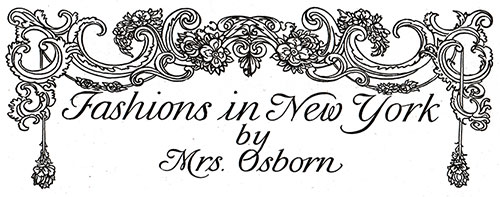
Since the skirt appears to have become the most important feature of a woman’s gown—the one that lends it tone and gives it the correct cachet— it is quite natural that it forms the chief topic in all discussions upon the fashions.
The “1830” skirt has not only arrived; it has been widely welcomed and is likely to make a lengthy stay. While the general contour of the new skirt accounts for its distinctive date, modern changes have made it much softer and infinitely more graceful than it was in its original form.
Those who copy the latter exactly, or who go to the extreme of stiffening the bottom of the skirt with cord or fine wire, are making a mistake in judgment. They are simply overshooting the mark at which* they aim.
The old-time half-balloon, half-pyramid effect may be true 1830 style, but it is decidedly out of fashion in 1904. It must not be forgotten for a moment that the idea underlying this Winter’s costuming is the desire to give the impression of slenderness and height.
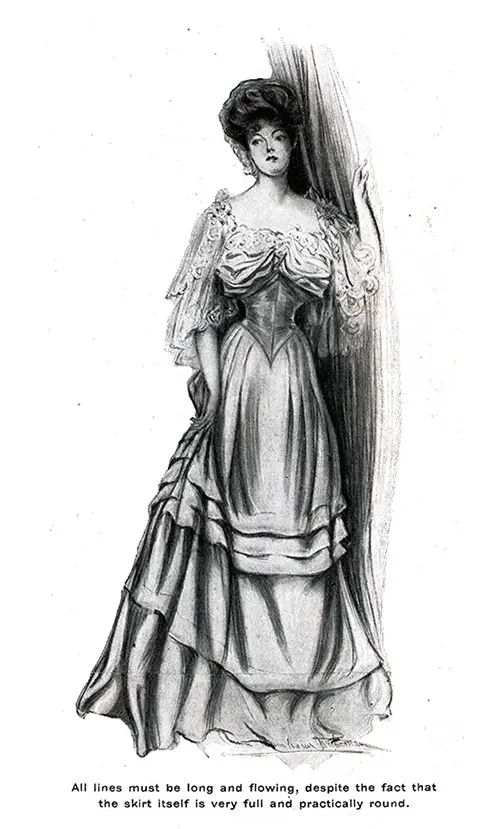
All lines must be long and flowing, despite the fact that the skirt itself is very full and practically round. A train is advisable only where the skirt is elaborately embroidered, but even then, it is very moderate in comparison with trains of recent years.
A noteworthy point in this season’s fashions is the marked resemblance in style and cut between the skirt for day wear and the one belonging to an evening gown.
Indeed, they are often exactly duplicated, the only perceptible difference appearing in the increased number of folds and in the kinds of trimming that are employed.
Exquisitely embroidered skirts of thin material are cut on precisely the same lines as those of cloth. Very likely this surprising similarity is due to the fact that the majority of the evening gowns are made of the new and particularly soft fabrics that drape so beautifully.
Clinging textiles are largely used, chiefly soft taffetas and brocades and embroidered satins. The very newest idea for evening gowns is to use beautiful brocades, more or less embroidered.
It is some time since this highly appropriate material has been seen in our ballrooms, and its reappearance is delightful.
I cannot too strongly emphasize the fact that the new skirt is very full—so full that a lining would make it stand out aggressively and thus destroy the highly fashionable clinging effect.
Consequently an underskirt of thin silk or of very fine muslin, fitted closely to the figure, is worn beneath the gown. This takes the place of the hitherto indispensable drop skirt.
The full skirt, contrary to expectations, does not make a woman look clumsy, provided it is properly cut and skillfully draped in the prevailing soft and graceful lines.
The extreme length of the front- and sides of the skirt adds very distinctly to the apparent height of the wearer. The skirt attains the best effect if it rest four or five inches upon the floor, all around, across the front and sides, as well as at the back.
Uncomfortable for walking? Of course it is! No one denies that. If comfort were the only point to be considered, we should all of us be dressed à la chinoise, I’m afraid.
But the length of the new skirt makes one believe that presently we shall see the ladies daintily lifting their skirts directly in the front, as in the days of the fair Empress Eugenie, and incidentally displaying glimpses of exquisite lingerie.
But steering away from prophecy and returning to plain matter of fact, let me state that for actual comfort while walking we now have the thoroughly practical “trotter” skirt, cut in short length and eminently suited to freedom of motion.
A few years ago women paid little attention to the details of what we at that time called the rainy-day skirt, and which was worn only in stormy weather. Very frequently an old skirt was cut off at the line of the ankle and finished to answer the immediate purpose.
No wonder that in those days the woman clothed in a short skirt felt apologetic, as well as ill-dressed, if she were seen in it after the sun had emerged from the clouds.
Today its legitimate and far more presentable successor, the trotter skirt, calls for as much care and thought in its development as does any other skirt.
It is the correct garment on many occasions, though the sky be never so blue; and the woman wearing it, in the city or in the country, will present a smart as well as a sensible appearance.
It is not generally known that the very first trotter skirt originated here. It was made for a charming American actress, who found it so convenient that she took it abroad with her and wore it in the streets of Paris itself.
The French dressmakers, appreciating its good points, immediately copied it. And now the trotter has returned home, assured of widespread popularity since it came via Paris and stamped with the magic seal of French approval.
The morning gown for shopping and for street wear should be quiet and subdued. At the same time it must impart to its wearer an air of distinction.
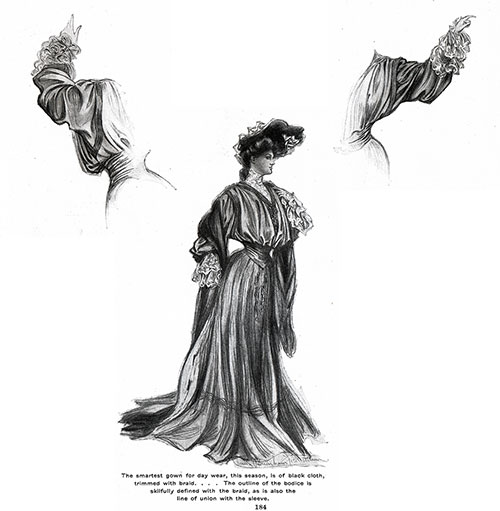
The smartest gown for day wear, this season, is of black cloth, trimmed with braid. But the braid must be of the finest quality, of silky luster and pliable as a ribbon.
The use of this variety of braid is not at all suggestive of the military effect one usually associates with braid trimmings. The braid is put on with hand sewing, in the prevailing straight lines, around the skirt, the yoke and over the top of the sleeve.
The outline of the bodice is skillfully defined with the braid, as is also the line of union with the sleeve. The braid must be sewed on carefully, much of it being attached along one edge only.
The illustrations on this page show this very newest sleeve. Front, back and side views are given with a clearness that should enable any one to copy it correctly.
I would call your attention to the unusual width and depth of the armhole and to the full, graceful sweep it makes where it springs from the under-arm seam.
Its soft drapery harmonizes perfectly with the flowing lines of the bodice, and it allows the wearer a freedom of movement hitherto permitted only by a kimono or a gymnasium suit.
In the illustration ruffles fall over the lower arm. An equally attractive finish is a mousquetaire cuff that begins at the elbow beneath the overhanging drapery.
It is shirred lengthwise over groups of two or three cords and buttoned snugly to the arm by means of tiny loops and crocheted rings, set along the inner seam that is open to the elbow.
This cuff may be of the costume material, or of the material used for the girdle and collar. It extends well over the hand and is finished with a tiny ruching or a fall of lace.
Naturally, in a season like this, where individual taste is unhampered, one is not absolutely confined to braid trimming upon a Street gown. Embroidery is frequently seen, and fur is always appropriate during the Winter months.
The boned bodice of the gown intended for day wear is no longer made in the familiar bloused Eton style. It is marked chiefly by a rather flat effect above the high girdle, such as was more fully treated in my letter of last month.
The sleeve is the feature that stamps the bodice with smartness— indeed, the skirt and sleeve may be said to make or mar the effect of the gown. If these be smart, the rest of the gown may safely be left to take care of itself.
There is much doubt expressed by those who know of the permanency of the draped sleeve. I should not be astonished to see a complete revolution in sleeves before the present year expires. We may even expect a return to the close-fitting sleeves of the earlier nineties.
The mousquetaire sleeve has already been adopted in many of the very smart cloth and velvet gowns for daytime wear, by women who have grown tired of the monotony of full and ruffled effects.
The regulation mousquetaire sleeve is used slightly modified, however, being made on broader lines in order to harmonize with the exaggerated length and breadth of this season’s shoulders.
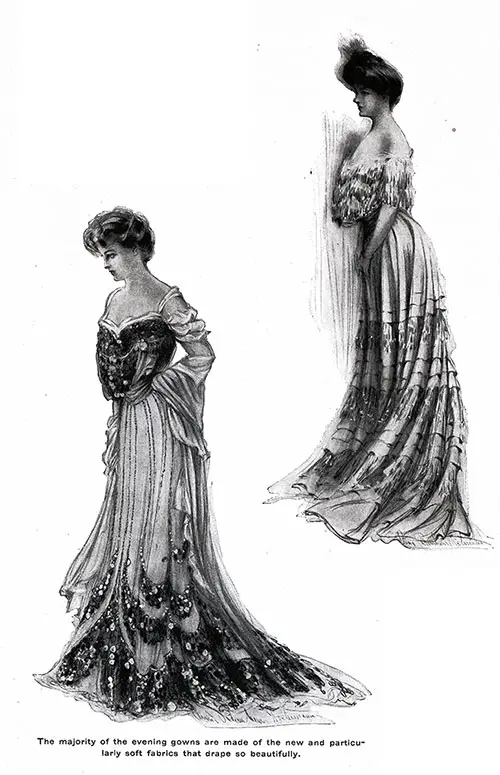
The majority of the evening gowns are made of the new and particularly soft fabrics that drape so beautifully.
The bodices for evening wear are occasionally finished with a fichu, in strict adherence to the general style of the “1830” period. But in order to obtain the smart 1904 effect, the dressmaker must arrange it with great exactness, so as to broaden the shoulders without destroying the fashionable droop.
Two ruffles hang down over the sleeve in natural and graceful curves. Particular attention is needed to adjust these and the fichu itself properly; the sweep must be made to follow the form closely, or the result will be a disagreeable effect in the back.
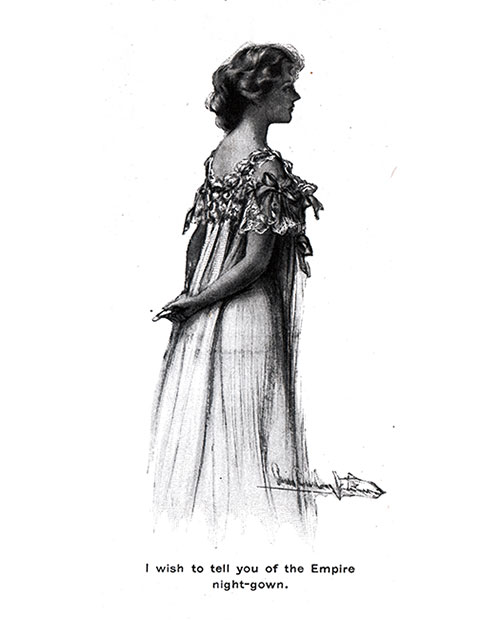
I wish to tell you about the Empire night-gown with its dainty lace insertion below the neck, from which the rest of the garment gracefully descends.
It has very little sleeves—just a strip of lace over the shoulders and across the arms—and sometimes hasn’t any sleeves at all. It is really more like an extra-long and wide chemise than a night-gown and is slipped on and off in the same easy manner.
Looking at the half-low neck, one is apt to think these garments not exactly practical for the American woman whose bedroom window is open all night, even in midwinter.
In warm weather they are ideally cool and altogether delightful; and if, because of their dainty simplicity, we should like to wear them when the snow flies and the temperature in our hygienic sleeping-rooms is correspondingly low, we can do so by following the example of our clever French sisters, who wear over them little jackets of washable silk in Winter, thus protecting the neck and arms.
There are more important points in which we could imitate the French women to our positive advantage. One of these is in the manner of ordering new gowns.
Perhaps I ought to say European women, for in Vienna and Berlin, in Frankfurt and London, even as in Paris, the woman who wishes a new gown puts herself entirely in the hands of her dressmaker.
This is not the case in this country, save in the wealthiest circles. As a natural result, the American dressmakers who dress the majority of women are behind the very latest fashions; not through lack of taste, nor through dearth of skill, but through sheer timidity in asserting themselves.
The customers of the average dressmaker think she does not know what is most suitable in their particular case. They quite forget that it is her business to know, and that no one can possibly be more eager for a good result in every instance, if only for financial reasons.
In their desire to have the details of a gown all planned out satisfactorily before even the scissors have been put into the material, they dictate to the dressmaker, and too often she allows herself to be led.
The inevitable outcome is timidity on the dressmaker’s part where decision should rule; obedience to a layman’s orders when professional advice should prevail, and a sacrifice of individuality, where confidence and encouragement should stimulate these.
Osborne, Josefa Wilson, “Fashions in New York by Mrs. Osborn,” in The Delineator: An Illustrated Magazine of Literature and Fashion, Paris-London-New York-Toronto: The Butterick Publishing Co. Ltd., Vol. LXIII, No. 2, February 1904, p. 183-185.

